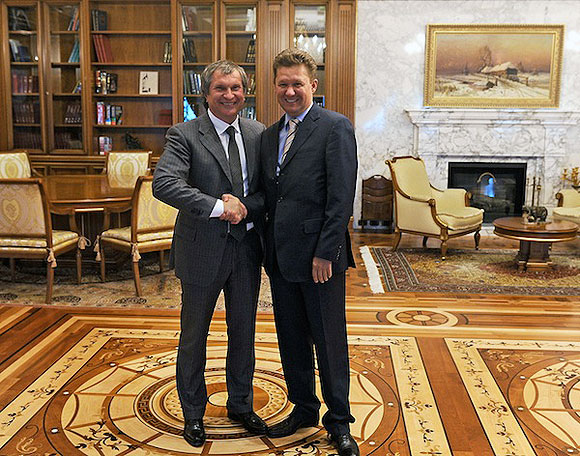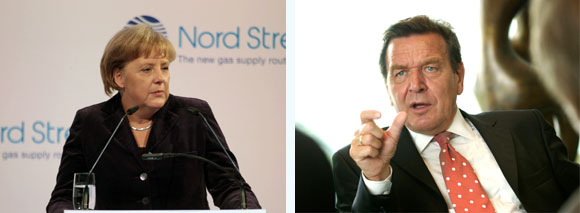Russia’s state capitalism reached a new high when Rosneft became the world’s largest publicly traded oil producer after its acquisition of TNK-BP. This new landscape is the result of the “national champions” strategy that was the heart of Vladimir Putin’s economic policy during his thirteen years in power. According to IMR economic advisor Igor Booth, the story of Gazprom, the world’s largest natural gas producer, provides good insight into the future of Rosneft and the Russian economy as a whole.

Rosneft CEO Igor Sechin (left) and Gazprom CEO Alexei Miller (right) preside over two largest monopolies in Russia. Apparently, both men are celebrating a new high of the state capitalism in the country.
As a member of the global corporate super-league, Gazprom is a good example of what national champions can achieve. For two consecutive years, the energy giant has earned more profits than any other company in the world. Between 1999 and 2007, Gazprom’s market capitalization skyrocketed, making it the third most valuable publicly traded company. In recognition of this success, Harvard Business Review named Alexey Miller, the company’s CEO, the best CEO of the emerging markets.
However, Gazprom’s major shareholder—the Russian Federation—has barely benefited from the company’s financial bonanza. The monopolist’s success was largely the result of wealth redistribution from its customers and the public to the pockets of company insiders. Today, however, Gazprom’s prospects seem uncertain because of major shifts in the world’s energy markets. Analysis of the company’s strategy over the past decade sheds some light on its future, as well as the future of its new sparring partner in the oil industry. An examination of the Gazprom case can help us understand the devastating consequences of state capitalism for the Russian economy.
Triumph of the Monopoly
Every corporate collapse is unique in its own way, but all successful companies are similar to each other in wielding substantial market power. Google, Apple, Microsoft, and Coca-Cola sustain their market dominance through patents, branding, and innovation. Gazprom’s financial success is based not only on high energy prices, but also on a successfully executed corporate strategy that has boosted the company’s market power.
Above all, the giant has managed to defend its exclusive access to Russia’s natural gas reserves. By the end of the 1990s, Gazprom’s monopoly on exploration and development had been eroded by the increasing penetration of Russian and international private companies, which had acquired a number of licenses for new natural gas fields. Soon after Putin came to power, this trend was reversed. Gazprom’s exclusive right to develop large natural gas fields was guaranteed by law. Within several years, the energy behemoth had swallowed all of its smaller competitors. These deals were facilitated by well-coordinated government campaigns against Gazprom’s acquisition targets.
After a barrage of tax claims, environmental fines, criminal charges, threats to withdraw licenses, and negative media campaigns, most owners were desperate to sell their natural gas assets at any price. In this way, Gazprom acquired control of Shell and TNK-BP’s large natural gas projects, forced Novatek to form an alliance, and bought up the assets of smaller companies Nortgas and Itera. These ruthless tactics blocked the emergence of independent natural gas producers.
The pipeline war proved a mixed bag for Gazprom. The development of liquid gas technology devalued investments in the construction of pipelines.
The second element of Gazprom’s strategy was to bundle its customers through long-term contracts and joint ventures. German, Italian, and French utilities perceived the establishment of close cooperative ties with Gazprom as an important competitive advantage. Deals with Gazprom turned these governments into the monopoly’s advocates in the European market. However, the dramatic 2008 drop in natural gas prices revealed these long-term agreements to be more favorable to Gazprom than to its partners. The Russian giant had outplayed the European energy behemoths.
“Divide and rule” has been Gazprom’s key tactic. Each client is offered its own natural gas price, which is kept secret. This way, the monopoly can extract from its consumers all of what they can pay. Smaller utilities, lacking access to any alternative gas suppliers, pay more than larger corporations, which are able to buy fuel elsewhere.
The third element of Gazprom’s strategy is its sustained control over the transportation network. The building of the Nord Stream pipeline through the seabed of the Baltic Sea secured the company’s independence from Belarus and Ukraine, which had previously leveraged their geographic position to receive healthy discounts from Gazprom. Today, Ukraine probably pays the highest price for natural gas than any other Gazprom client. Furthermore, Gazprom has successfully blocked all alternative pipeline routes designed to transport natural gas from the Caspian region to Europe.
However, the pipeline war proved a mixed bag for Gazprom. The development of liquid gas technology devalued investments in the construction of pipelines. Now these pipelines stay idle as Europe switches from pricy Siberian natural gas to liquefied gas and coal.

Nord Stream is Gazprom's largest energy and political project. The second stretch of the gas pipeline's was launched in October, 2012, thus doubling its capacities to 55 billion cubic meter of gas per year.
As a fourth prong of its strategy, Gazprom has lobbied for price increases on the domestic market. As a result, Russian companies today pay more for natural gas than their American peers. This was yet another victory for Gazprom over its customers. High domestic natural gas prices support the company’s profitability at a time of sluggish demand abroad.
Gazprom’s success is not driven by such traditional engines as new technologies, cost cutting, or entry into new markets. In fact, the monopoly’s output has fallen over the last ten years. The company consistently spends several times more on its investment projects than it declares. It overlooked shale gas and liquefied gas technologies, failed to acquire substantial expertise in offshore drilling, lost the fast-growing Chinese market, and missed the opportunity to promote natural gas as an automobile fuel in Russia.
Overall, Gazprom behaves as a typical monopoly, maximizing its profits through price increases and output cuts. The profits derived from innovations and cost cutting are beans compared with the profits drawn from a monopoly status and astonishing natural resource royalties.
Where Is the Money?
According to a popular Russian comic song, it is better to be a Gazprom shareholder than a prime minister. Indeed, the monopoly’s shareholders own a successful company with an outstanding financial performance and in theory should enjoy healthy dividends and a share in price growth. Alas, Gazprom is not generous when it comes to paying dividends. Ambitious expansion plans and a heavy debt burden consume most of the company’s profits. Still, the company’s capitalization skyrocketed at the beginning of the 2000s thanks to the liberalization of its ownership structure. Before 2003, foreigners were not allowed to invest in Gazprom. Those who knew about the government’s plans to eliminate restrictions on the company’s stock ownership made a killing.
Among the beneficiaries of Gazprom’s capitalization jump can be found many former and current government officials and well-connected Russian tycoons—but not the company’s major shareholder, the Russian Federation. The government could have realized profits by selling its shares when the company’s capitalization peaked. However, while the stock price grew, the government was buying, not selling, its shares to restore its formal control over Gazprom.

As Chancellor of Germany, Gerhard Shroeder (right) became Gazprom's number one ally in Europe, lobbying for its projects. Angela Merkel, who took over the office after Shroeder, continued to maintain close ties with the Russian gas company.
Though Gazprom leads the global energy ranks in terms of profits, its market value is less than that of the other major oil and gas companies. Investors do not anticipate that they will ever receive a fair share of the monopoly’s profits and doubt that the company will be able to sustain its current level of profitability in the future. Reflecting investors’ disappointment, the company’s capitalization fell from $364 billion in 2007 to just $110 billion in October 2012. During the same time-period, Gazprom fell in the Financial Times’ rankings of the world’s 500 most valuable companies from the third to the thirty-first position.
Gazprom’s multi-billion-dollar profits do not disappear without a trace. Contractors that sell the company everything, from pipes to consulting services, are the major recipients of the monopoly’s fortunes.
Though the government is not an efficient owner, some economists believe that in an emerging economy, it is much easier to collect taxes from a state-controlled company than a private one. In practice, the Russian natural gas industry has enjoyed favorable taxation in comparison with the private-owned oil industry. State-controlled Gazprom and Rosneft are the major recipients of the specially tailored tax exemptions for the development of new fossil fuel deposits.
In the absence of any direct financial benefits from Gazprom, the public may wish to receive indirect positive economic effects from the monopoly. The “national champions” policy promoted by Putin relies on the ability of these companies to execute ambitious breakthrough projects that are important for national economic development but are too risky and costly for private investors to pursue. Gazprom was entrusted with developing several projects that could have changed the economies of entire regions. Surprisingly, it was Shell that completed the only really breakthrough project in the Russian natural gas industry in the last thirty years. Like many others, the Dutch company was forced to sell its share in the project just months before it started generating profits. Most of Gazprom’s current projects are either postponed or frozen.
Until recently, Gazprom’s privileges were often justified by the low natural gas prices that it maintained in the domestic market. According to a common belief, Gazprom “subsidized the whole economy.” Though the natural gas price in Russia is still much lower than Gazprom’s export price, the domestic price could have been even lower had the market been liberalized. Low natural gas prices in the United States demonstrate how fair competition among producers can drive prices down.
Of course, Gazprom’s multi-billion-dollar profits do not disappear without a trace. Gazprom contractors that sell the company everything, from pipes to consulting services, are the major recipients of the monopoly’s fortunes. There are plenty of intermediaries surrounding the company, including those who buy its assets cheap and sell them high. Over the past ten years, there have been multiple cases in which Gazprom-related multi-billion-dollar construction or financial businesses emerged out of nowhere, only to disappear after their owners lost favor with the monopoly’s upper management.

